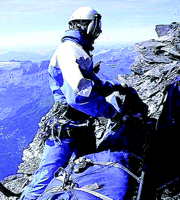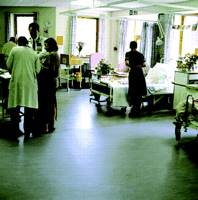This week in the BMJ
Volume 326, Number 7395, Issue of 26 Apr 2003Descent is mainstay of altitude illness treatment
Screening 1000 women for 35 years prevents one cervical cancer death
Delay in TB diagnosis is more common in white people and women
PFI is ineffective
Assessment of bed blocking lacks valid tools
Manual therapy is cost effective for treating neck pain
Descent is mainstay of altitude illness treatment
Altitude illness is best handled by stopping further ascent, but severe
or persistent symptoms require descending, aided by oxygen and drug
treatment. In a clinical review, Barry and Pollard (p 915) explain the
symptoms and forms of the illness and the available treatments. In most
cases, altitude illness is a self limiting and benign syndrome, but it
can progress to life threatening forms, such as pulmonary or cerebral
oedema. It is common in travellers to altitudes over 2500 m, and the
mainstay of treatment is descending. The authors say that doctors
should view oxygen and drug treatment as adjuncts to aid descent.

(Credit: DMTM CHAMONIX)
Screening 1000 women for 35 years prevents one cervical cancer death
In the NHS cervical screening programme, 10 000 women need to be
screened for 35 years to prevent 10 out of the 25 deaths estimated to
occur without screening. Raffle and colleagues (p 901) analysed the
screening records of 350 000 women in Bristol across 20 years and
modelled cases of cervical cancer and deaths with and without
screening. According to their model, for each death prevented, 152 women have abnormal test results, 79 are referred for investigation,
and 53 have treatment. The authors draw attention to the fact that
because screening is resource intensive and potentially harmful, good
evidence on all its outcomes is required.
Delay in TB diagnosis is more common in white people and women
Diagnoses of tuberculosis in London between 1998 and 2000 were
made a median of seven weeks after onset of symptoms, and delay in
diagnosis was more likely in white people and women. Rodger et al
(p 909) analysed surveillance data and a national survey and found a
median of 49 days from onset of symptoms of tuberculosis to diagnosis
or treatment. Looking at the variables of ethnic group and sex, they
found that diagnosis after the median time was more likely in white
people and women. Time since entry into the United Kingdom was also
positively associated with delay; age and birthplace were not.
PFI is ineffective
The private finance initiative (PFI) implemented in Lothian,
Scotland, led to capacity constraints across all acute specialties and
downsizing of hospital and community provision. Dunnigan and Pollock
(p 905) analysed projected and actual trends in bed capacity and
inpatient and day case admissions for the Lothian healthcare plan, and
compared the results with those from the rest of Scotland. Rates for
inpatient admission in all specialties and for day case admissions in
acute specialties were significantly lower in Lothian hospitals than in
the rest of Scotland, while the proportion of delayed discharges in
staffed beds was higher. The authors conclude that PFI did not reach
its targets, and further downsizing may be required due to its high
costs.

(Credit: STOCKBYTE/REX)
Assessment of bed blocking lacks valid tools
The evaluation of inappropriately delayed discharge is beset by poor
measurement tools, poor evidence, and problems of lack of definition.
Vetter (p 927) examined the evidence from systematic reviews and other
studies and found that the current tools for measuring bed blocking
have poor validity and reproducibility, which increases when local
availability of alternative care is ignored. The author found no strong
evidence to show that in cases labelled as inappropriately delayed
discharge the patients would have had better outcomes if they had been
discharged earlier.

Manual therapy is cost effective for treating neck pain
Manual therapy (spinal mobilisation) is more effective and less costly
than physiotherapy or care by a general practitioner for treating neck
pain. Korthals-de Bos and colleagues (p 911) conducted an economic
evaluation comparing the cost effectiveness of three different
treatments for patients with neck pain. After 26 weeks, patients having
manual therapy had higher recovery rates than those having
physiotherapy or being cared for by a general practitioner, but these
rates were similar after 52 weeks. Total costs in the manual therapy
group were around a third of the costs in the other two
groups.

(Credit: STOCKBYTE/REX)